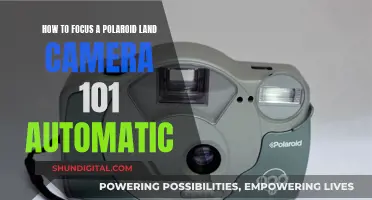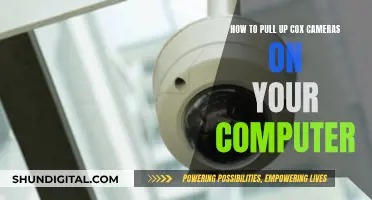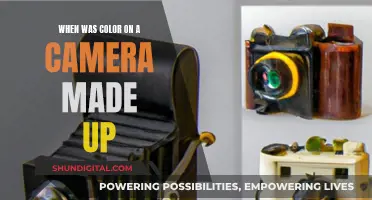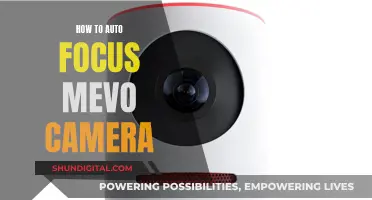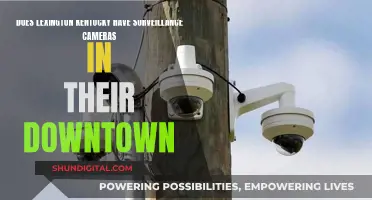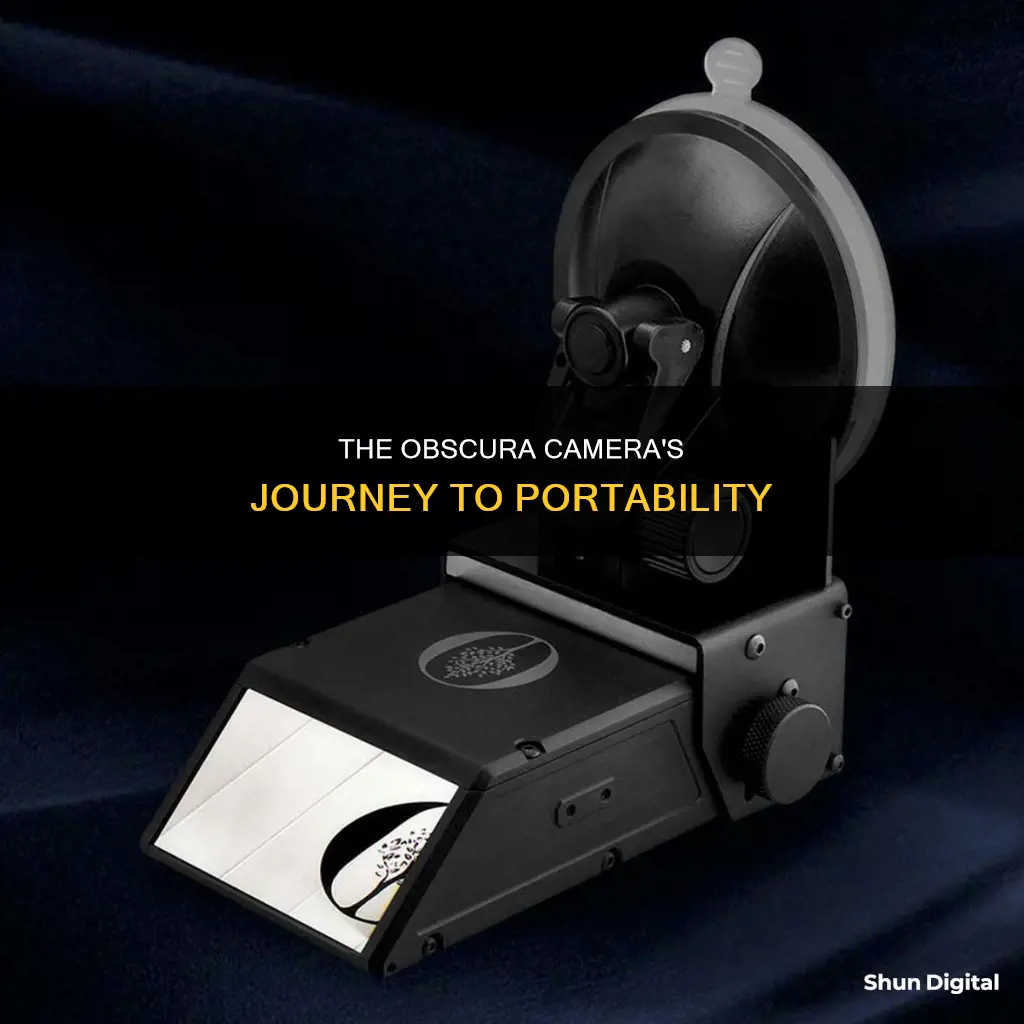
The camera obscura, a device that uses a dark room or box to project an image through a small hole, has a long history that dates back to the 5th century BCE. The first portable version of the camera obscura was created by German astronomer Johannes Kepler in 1604. Kepler's version of the camera obscura was a tent that he carried around and used for surveying Upper Austria. Later, in the 17th and 18th centuries, a box-like version of the camera obscura was created and used by artists such as Vermeer and Canaletto.
| Characteristics | Values |
|---|---|
| When was the camera obscura made portable | In the 17th century, a portable version of the camera obscura was created by German astronomer Johannes Kepler. |
| Who created the portable version | Johannes Kepler |
| What did the portable version consist of | A portable box with a small opening in one side |
| What was the purpose of the portable version | To make the device more practical for artists |
What You'll Learn

The first portable camera obscura was a tent
The camera obscura is a Latin term that means "dark chamber" or "dark room". It is an optical device that creates an image by focusing rays of light onto a screen or sheet of paper. The camera obscura device is box-shaped and is used as an aid for drawing or entertainment. The human eye works similarly to the camera obscura; both have an opening (pupil), a biconvex lens for refracting light, and a surface where the image is formed (retina).
The camera obscura was made portable by German astronomer Johannes Kepler in 1604. The first portable camera obscura was a tent, which Kepler used for surveying Upper Austria. This was followed by the creation of a portable box-like version, which was used by artists in the 17th and 18th centuries, such as Vermeer and Canaletto.
The benefits of the camera obscura for artists were noted by the Venetian nobleman Daniele Barbaro in 1568:
> There on the paper you will see the whole view as it really is, with its distances, its colours and shadows and motion, the clouds, the water twinkling, the birds flying. By holding the paper steady, you can trace the whole perspective with a pen.
The camera obscura was originally developed as a scientific instrument, but it appealed to artists who used it as an aid to drawing outdoors. While the optical principles behind the camera obscura had been known since ancient times, portable devices were first available towards the end of the 16th century. Previous models would have been too unwieldy to be of practical use for artists.
The camera obscura helped artists render the correct perspective of views seen from eye level. It is believed that Canaletto used a camera obscura for his drawing "View of Santa Maria Formosa toward the Right Side of the Square". The sheet of paper was not large enough to include the top of the bell tower, which floats to the right. If the top were superimposed onto the tower, it would fit precisely, suggesting that the artist simply moved the paper to catch the image projected from the lens of a camera obscura.
Troubleshooting SpyPoint Camera Battery Drain
You may want to see also

Portable versions were made from wooden boxes
The camera obscura is a device that uses a dark room or box with a small hole or lens to project an image from outside onto a surface inside. The image is projected upside down and is a mirror image of the scene outside. The name 'camera obscura' is Latin for 'dark chamber' or 'dark room'.
The camera obscura was first described by Chinese philosopher Mozi in the 5th century BCE. However, it was not until the 11th century that a viewing screen was used to project the image. The first use of the term 'camera obscura' is attributed to German mathematician, astronomer, and astrologer Johannes Kepler in 1604.
Kepler also created a portable version of the camera obscura that he carried around with him as a tent for surveying Upper Austria. This was still quite a large object, so a more portable box-like version was created. These portable versions were made from wooden boxes and often had lenses instead of pinholes, allowing users to adjust the focus. Some of these portable camera obscuras also featured an angled mirror, allowing the image to be projected the right way up.
The portable camera obscura was used by artists in the 17th and 18th centuries, such as Vermeer and Canaletto. The device was controversial, as many viewed the tracing method as cheating. However, it allowed artists to achieve perfect perspective in their work. The camera obscura was also a precursor to the photographic camera, with early photographic cameras based on the portable box design.
BestBuy's Camera Restocking Fee: Why the Extra Charge?
You may want to see also

The image is projected onto a screen or paper
The camera obscura is an optical device that projects an image by focusing rays of light onto a screen or sheet of paper. The image is projected upside down and reversed (left to right). The surroundings of the projected image must be relatively dark for the image to be clear.
The camera obscura was used as an aid for drawing and entertainment. As a drawing aid, it allowed artists to trace the projected image, producing a highly accurate representation. It was especially useful for achieving proper graphical perspective. Artists would set up the camera obscura outdoors, with the subject of the drawing positioned outside, and the image reflected on a piece of drawing paper.
The camera obscura was also used to study eclipses without damaging the eyes by looking directly into the sun.
The image projected by the camera obscura can be viewed from the back so that it is no longer reversed, but still upside down. Using mirrors, it is possible to project a right-side-up image. The projection can also be displayed on a horizontal surface, such as a table.
The box-type camera obscura often has an angled mirror projecting an upright image onto tracing paper placed on its glass top. Although the image is viewed from the back, it is reversed by the mirror.
The camera obscura was made portable by German astronomer Johannes Kepler, who created a tent version in 1604. Later, more portable variants were invented, including wooden boxes with lenses instead of pinholes, which could be moved to provide focus. These cameras were the basis for early photographic cameras.
Fujifilm Camera Not Charging: Troubleshooting Guide
You may want to see also

The camera obscura was used to study eclipses
The camera obscura is a Latin term that translates to "dark chamber". It is a natural phenomenon where light rays pass through a small hole into a dark space, forming an inverted and reversed projection of the outside view. This projection can be viewed on a translucent screen or from the outside of the box. The technology was further developed into the photographic camera in the first half of the 19th century, with camera obscura boxes being used to expose light-sensitive materials to the projected image.
The earliest known written account of the camera obscura dates back to the 5th century BC by the Chinese philosopher Mozi. However, it is believed that the device was used even before that, possibly as early as 400 BC. Mozi observed that light passing through a pinhole into a dark room created an inverted image. This principle was later applied to the study of eclipses, providing a safe way to observe the phenomenon.
In the 4th century BC, Greek philosopher Aristotle made a similar observation, noting that a partial eclipse could be viewed by looking at the ground beneath a tree. The crescent shape of the partially eclipsed sun was projected onto the ground through the gaps in the leaves, allowing him to view it safely. This method of observing eclipses was also utilised by the 11th-century Arab scientist Alhazen, who is credited with inventing the camera obscura.
The use of the camera obscura to study eclipses continued into later centuries. In the 16th century, Dutch physician Gemma Frisius used a camera obscura to study the solar eclipse of 24 January 1544, publishing the first illustration of the device in his book "De Radio Astronomica et Geometrica". In the following century, German mathematician Johannes Kepler used a portable version of the camera obscura, carrying it with him as a tent for surveying Upper Austria.
Charging Camera Batteries: USB Option for Photographers
You may want to see also

The camera obscura was a forerunner of the modern camera
The camera obscura was initially a room, but later became a portable box with a small opening on one side. Light enters the box through a lens and projects an image onto the opposite surface. This image is upside down and reversed, like the one formed on the human retina. Portable versions of the camera obscura often included a lens, allowing users to adjust the focus. Some also featured an angled mirror, allowing the image to be projected the right way up.
The camera obscura was used for viewing astronomical phenomena and as a model of the structure and function of the eye. It was also used as a drawing aid, allowing artists to trace the projected image onto their canvas. The use of the camera obscura as a compositional aid for artists has been a subject of debate among art historians. While there is little written evidence of its use prior to the 18th century, many scholars believe that the extreme contrasts of perspective and thickly painted highlights in Vermeer's paintings, for example, are evidence of the use of an optical device.
In the first half of the 19th century, the camera obscura was developed further into the photographic camera when camera obscura boxes were used to expose light-sensitive materials to the projected image.
Logitech Circle Camera: How Long Does the Battery Last?
You may want to see also
Frequently asked questions
The camera obscura was made portable in the 16th century.
German astronomer Johannes Kepler created a portable version of the camera obscura in the form of a tent.
Many scientists and philosophers experimented with the camera obscura, including Mozi, Aristotle, Alhazen (Ibn al-Haytham), Leonardo da Vinci, Giambattista della Porta, and more.
The camera obscura is an optical device that creates an image by focusing rays of light onto a screen or paper. It is the predecessor of the modern camera.
The camera obscura works by allowing light to enter through a small opening or pinhole, projecting an inverted image on the opposite surface. More complex versions use lenses and mirrors to adjust the focus and orientation of the image.


